phone MERCEDES-BENZ R-CLASS FAMILY TOURER 2013 Owners Manual
[x] Cancel search | Manufacturer: MERCEDES-BENZ, Model Year: 2013, Model line: R-CLASS FAMILY TOURER, Model: MERCEDES-BENZ R-CLASS FAMILY TOURER 2013Pages: 364, PDF Size: 28.68 MB
Page 15 of 364
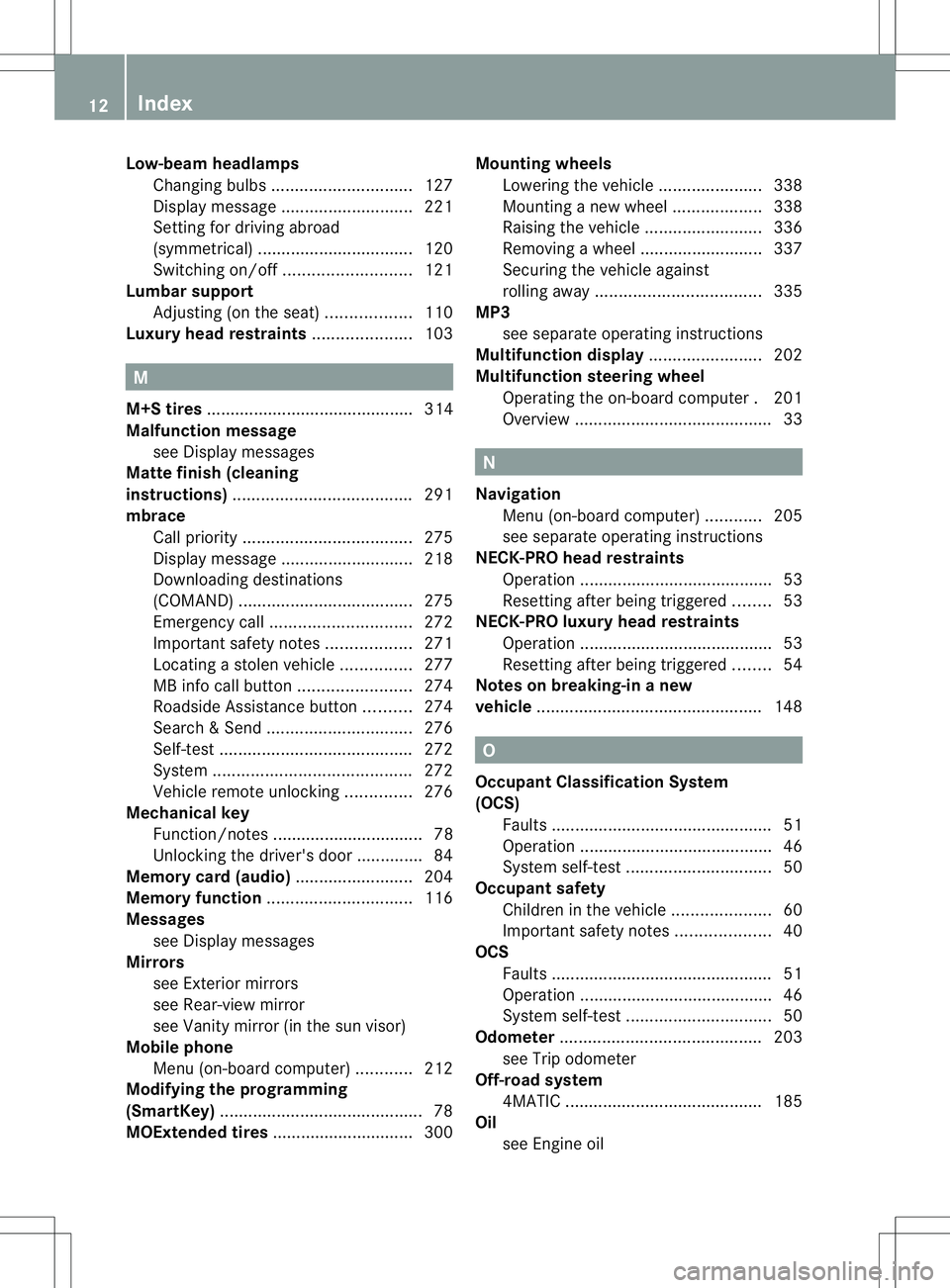
Low-beam headlamps
Changing bulbs .............................. 127
Display message ............................ 221
Setting for driving abroad
(symmetrical) ................................. 120
Switching on/off ........................... 121
Lumbar support
Adjusting (on the seat) ..................110
Luxury head restraints .....................103 M
M+S tires ............................................ 314
Malfunction message see Display messages
Matte finish (cleaning
instructions) ...................................... 291
mbrace Call priority .................................... 275
Display message ............................ 218
Downloading destinations
(COMAND) ..................................... 275
Emergency call .............................. 272
Important safety notes ..................271
Locating astolen vehicl e............... 277
MB info call button ........................274
Roadside Assistance button ..........274
Search &Send ............................... 276
Self-test ......................................... 272
System .......................................... 272
Vehicle remote unlocking ..............276
Mechanical key
Function/notes ................................ 78
Unlocking the driver's door ..............84
Memory card (audio) .........................204
Memory function ............................... 116
Messages see Display messages
Mirrors
see Exterior mirrors
see Rear-view mirror
see Vanity mirror (in the sun visor)
Mobile phone
Menu (on-board computer) ............212
Modifying the programming
(SmartKey) ........................................... 78
MOExtende dtires .............................. 300 Mounting wheels
Lowerin gthe vehicle ...................... 338
Mounting anew wheel ................... 338
Raising the vehicle .........................336
Removing awheel .......................... 337
Securing the vehicle against
rolling away ................................... 335
MP3
see separate operating instructions
Multifunction display ........................202
Multifunction steering wheel Operating the on-board computer .201
Overview .......................................... 33 N
Navigation Menu (on-board computer) ............205
see separate operating instructions
NECK-PRO head restraints
Operation ........................................ .53
Resetting after being triggered ........53
NECK-PRO luxury head restraints
Operation ........................................ .53
Resetting after being triggered ........54
Notes on breaking-in anew
vehicle ................................................ 148 O
Occupant Classification System
(OCS) Faults ............................................... 51
Operation ........................................ .46
System self-test ............................... 50
Occupant safety
Childrenint he vehicle..................... 60
Important safety notes ....................40
OCS
Faults ............................................... 51
Operation ........................................ .46
System self-test ............................... 50
Odometer ........................................... 203
see Trip odometer
Off-road system
4MATIC .......................................... 185
Oil
see Engine oil 12
Index
Page 16 of 364

On-board computer
Additional functions menu .............211
AIRMATIC/compass menu ............205
Audi omenu ................................... 204
Convenience submenu ..................210
Displaying a service message ........288
Displaying the coolant
temperature ................................... 203
Displaying the outside
temperature ................................... 203
Display messages ..........................214
DISTRONI Cmenu .......................... 180
Factory settings ............................. 206
Important safety notes ..................200
Menu overview .............................. 202
Message memory menu ................. 214
Navigation menu ............................ 205
Operation ....................................... 201
Selecting the language ..................207
Settings menu ............................... 206
Standard display. ........................... 203
Status bar ...................................... 207
Telephone menu ............................ 212
Trip computer menu ......................211
Video DVD operation. ....................205
Opening and closing the side trim
panels ................................................. 129
Operating system see On-board computer
Outside temperature
Calling up (on-board computer) .....203
Outside temperature display ...........201
Overhead control panel ......................36
Override feature Rea rside windows ........................... 67 P
Pain tcode number ............................ 349
Paintwork (cleaning instructions) ...291
Panic alarm .......................................... 40
Panorama roof with power tilt/
sliding panel
Opening/closing .............................. 95
Opening/closing the roller
sunblind ........................................... 96
Problem (malfunction) .....................97
Resetting ......................................... 96Panorama sliding sunroof
Important safety notes ....................93
Parking ............................................... 166
Important safety notes ..................166
Parking brake ................................ 167
Position of exterior mirror, front-
passenger side ............................... 116
Rea rview camera .......................... 189
see PARKTRONIC
Parking aid
see Exterior mirrors
see PARKTRONIC
Parking brake
Display message ............................ 217
Notes/function .............................. 167
Warning lamp ................................. 244
Parking lamps (changing bulbs) ......128
PARKTRONIC Deactivating/activating .................188
Driving system ............................... 186
Function/notes ............................. 186
Important safety notes ..................186
Problem (malfunction) ...................189
Range of the sensors .....................186
Trailer towing ................................. 188
Warning displa y............................. 187
PASSENGE RAIR BAG OFF indicator
lamp ...................................................... 46
Plastic trim (cleaning instructions) .294
Power washers .................................. 291
Power windows see Side windows
PRE-SAFE ®
(anticipatory occupant
protection) Display message ............................ 218
Operation ........................................ .52
Product information ............................21
Program selector button ..................157
Pulling away (automatic
transmission) ..................................... 151 Q
Qualifie dspecialis tworkshop ...........24 Index
13
Page 20 of 364

Locating
astolen vehicl e............... 277
MB info call button ........................274
Roadside Assistance button ..........274
Search &Send ............................... 276
Self-test ......................................... 272
System .......................................... 272
Vehicle remote unlocking ..............276
Telephone
Accepting acall............................. 213
Display message ............................ 236
Menu (on-board computer) ............212
Number from the phone book ....... .213
Redialing ........................................ 213
Rejecting/ending acall................. 213
Temperature
Coolant (on-board computer) ......... 203
Displaying the outside
temperature ................................... 203
Outside temperature ..................... .201
Setting (climate control) ................140
Theft deterrent systems
ATA (Anti-Theft Alarm system) .........72
Immobilize r...................................... 72
Tire pressure
Calling up (on-board computer) .....320
Checking manually ........................319
Display message ............................ 231
Maximum ....................................... 318
Notes ............................................. 317
Recommended ............................... 316
Tire pressure loss warning system
Important safety notes ..................319
Restarting ...................................... 320
Tire pressure monitor
Checking the tire pressure
electronically ................................. 322
Warning message .......................... 322
Tire pressure monitoring system
Function/notes ............................. 320
Restarting ...................................... 322
Warning lamp ................................. 247
Tires
Aspect ratio (definition) .................333
Average weight of the vehicle
occupants (definition) ....................332
Bar (definition) ............................... 331
Changing awheel .......................... 334
Characteristics .............................. 331Checking ........................................ 313
Definition of terms
.........................331
Directio nofrotation ...................... 334
Display message ............................ 231
Distributio nofthe vehicle
occupants (definition) ....................334
DOT, Tire Identification Number
(TIN) .............................................. .331
DOT (Department of
Transportation) (definition) ............332
GAWR (Gross Axle Weight Rating)
(definition) ..................................... 332
GTW (Gross Trailer Weight)
(definition) ..................................... 332
GVW (Gross Vehicle Weight)
(definition) ..................................... 332
GVWR (Gross Vehicle Weight
Rating) (definition) .........................332
Important safety notes ..................312
Increased vehicle weight due to
optional equipment (definition) ......332
Kilopascal (kPa) (definition) ...........332
Labeling (overview )........................ 328
Load bearing index (definition) ......333
Load index ..................................... 330
Load index (definition) ...................333
M+S tires ....................................... 314
Maximum loaded vehicle weight
(definition) ..................................... 332
Maximum load on a tire
(definition) ..................................... 333
Maximum permissible tire
pressure (definition) ....................... 333
Maximum tire load. ........................330
Maximum tire load (definition) .......333
MOExtended tires ..........................314
Optional equipment weight
(definition) ..................................... 333
PSI (pounds per square inch)
(definition) ..................................... 333
Replacing ....................................... 334
Service life ..................................... 314
Sidewall (definition) .......................333
Speed rating (definition) ................332
Storing ........................................... 335
Structure and characteristics
(definition) ..................................... 331
Temperature .................................. 327 Index
17
Page 36 of 364

Multifunction steering wheel
Function Page
:
Multifunction display 202
;
COMAND; see the separate
operating instructions
=
~
Rejects or ends a call 212
Exits phone book/redial
memory
6
Makes or accepts a call
Switches to the redial
memory
WX
Selects submenus in the
Settings
menu 206
Changes values
Adjusts the volume Function Page
?
Switches on the Voice
Control System; see the
separate operating
instructions
?
VU
Selects a menu: scrolls
back and forth
202
A
Switches off the Voice
Control System; see the
separate operating
instructions
&*
Scrolls back and forth
withi
namenu 202Multifunction steering wheel
33At a glance
Page 39 of 364
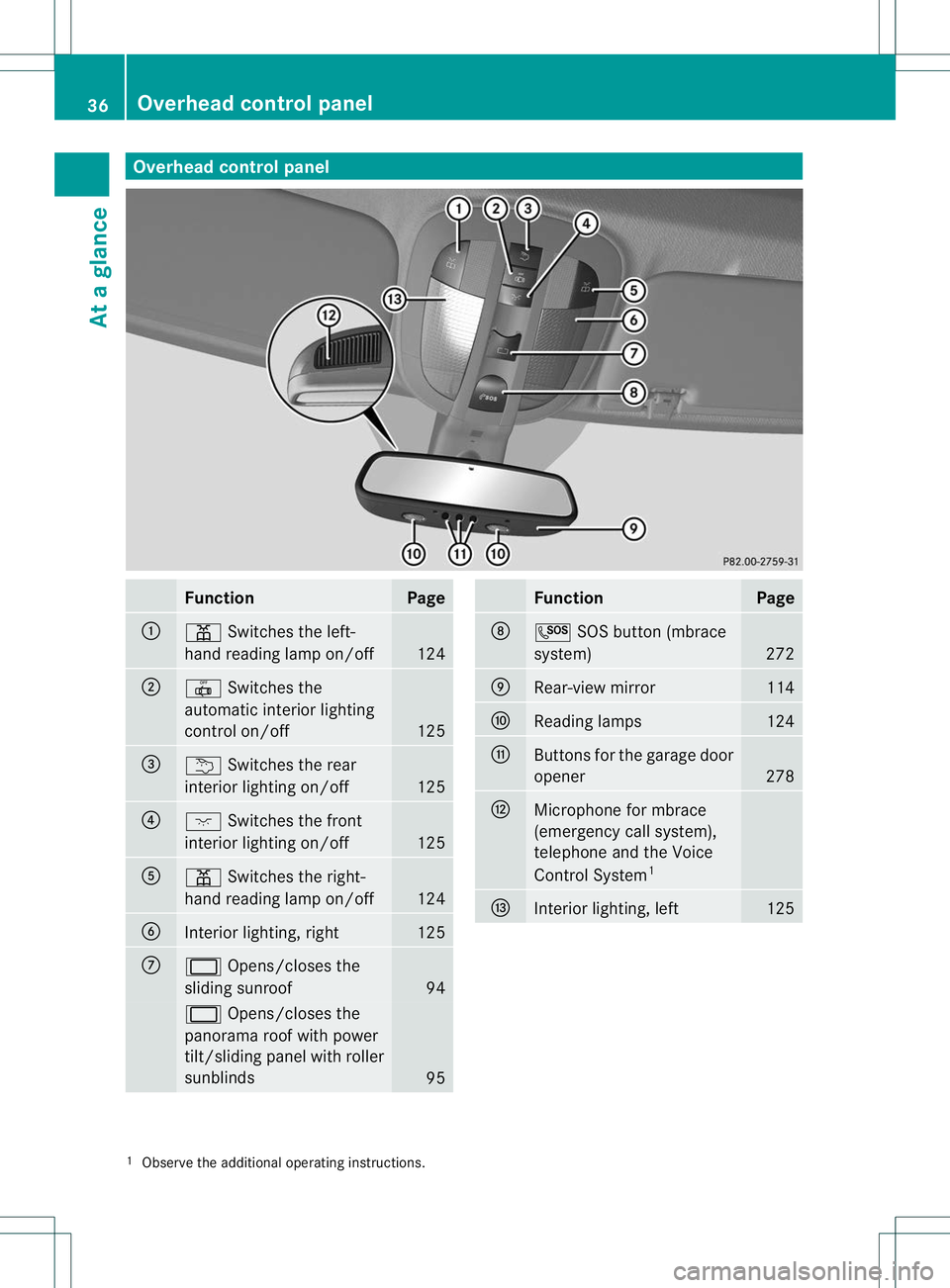
Overhea
dcontrol panel Function Page
:
p
Switches the left-
hand reading lamp on/off 124
;
|
Switches the
automatic interio rlighting
control on/off 125
=
u
Switches the rear
interior lighting on/off 125
?
c
Switches the front
interior lighting on/off 125
A
p
Switches the right-
hand reading lamp on/off 124
B
Interior lighting, right 125
C
2
Opens/closes the
sliding sunroof 94
2
Opens/closes the
panorama roof with power
tilt/sliding panel with roller
sunblinds 95 Function Page
D
G
SOS button (mbrace
system) 272
E
Rear-view mirror 114
F
Reading lamps 124
G
Buttons for the garage door
opener
278
H
Microphone for mbrace
(emergency call system),
telephone and the Voice
Control System
1 I
Interior lighting, left 125
1
Observe the additional operating instructions. 36
Overhead control panelAt a glance
Page 76 of 364

X
To switc hoff using KEYLESS-GO: unlock
the vehicle with KEYLESS-GO.
or
X Press the Start/Stop button on the
dashboard. The SmartKey must be inside
the vehicle.
Av isual and audible alarm is triggered if the
alarm system is armed and you open:
R a door
R the vehicle with the mechanical key
R the tailgate
R the hood
X To turn the alarm off with the
SmartKey: press the%or& button
on the SmartKey.
The alarm is switched off.
or
X Insert the SmartKey into the ignition lock.
The alarm is switched off.
X To stop the alar musing KEYLESS-GO:
grasp the outside door handle. The
SmartKey must be outside the vehicle.
The alarm is switched off.
or
X Press the Start/Stop button on the
dashboard. The SmartKey must be inside
the vehicle.
The alarm is switched off.
The alarm is not switched off, even if you
close the open door that has triggered it, for
example.
i If the alarm stays on for more than
30 seconds, the mbrace (USA only) or TELE
AID (Canada only) emergency call system
initiates a call to the Customer Assistance
Center automatically. The emergency call
system initiates the call provided that:
R you have subscribed to the mbrace/
TELEAID Service.
R the mbrace/TELEAID Service has been
activated properly.
R the required mobile phone, power supply
and GPS are available. Theft deterrent locking system
73Safety Z
Page 80 of 364
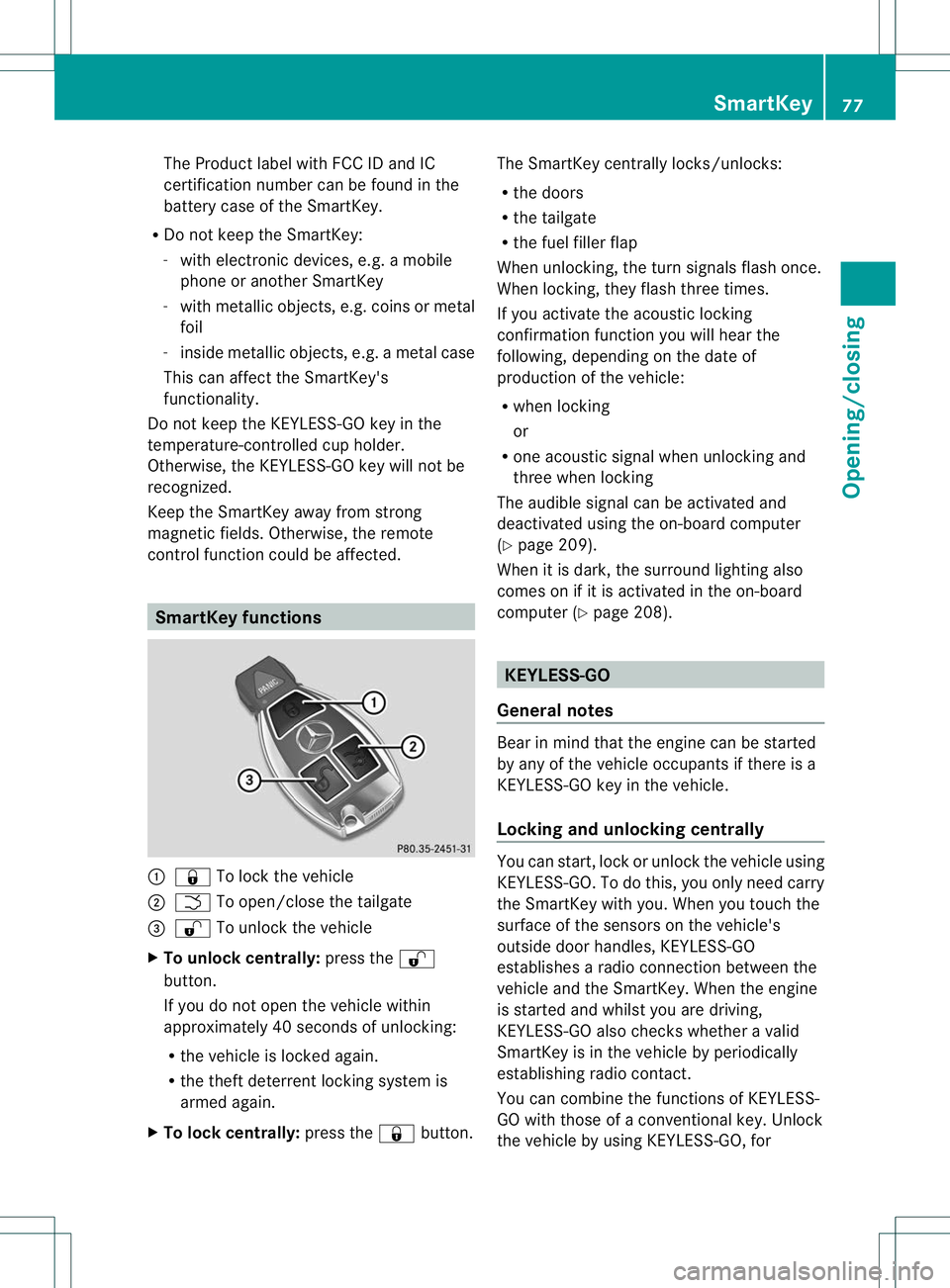
The Product label with FCC ID and IC
certification number can be found in the
battery case of the SmartKey.
R Do not keep the SmartKey:
-with electronic devices, e.g. a mobile
phone or another SmartKey
- with metallic objects, e.g. coins or metal
foil
- inside metallic objects, e.g. a metal case
This can affect the SmartKey's
functionality.
Do not keep the KEYLESS-GO key in the
temperature-controlled cup holder.
Otherwise, the KEYLESS-GO key will not be
recognized.
Keep the SmartKey away from strong
magnetic fields. Otherwise, the remote
control function could be affected. SmartKey functions
:
& To lock the vehicle
; F To open/close the tailgate
= % To unlock the vehicle
X To unlock centrally: press the%
button.
If you do not open the vehicle within
approximately 40 seconds of unlocking:
R the vehicle is locked again.
R the theft deterrent locking system is
armed again.
X To lock centrally: press the&button. The SmartKey centrally locks/unlocks:
R
the doors
R the tailgate
R the fuel filler flap
When unlocking, the turn signals flash once.
When locking, they flash three times.
If you activate the acoustic locking
confirmation function you will hear the
following, depending on the date of
production of the vehicle:
R when locking
or
R one acoustic signal when unlocking and
three when locking
The audible signal can be activated and
deactivated using the on-board computer
(Y page 209).
When it is dark, the surround lighting also
comes on if it is activated in the on-board
computer (Y page 208). KEYLESS-GO
General notes Bear in mind that the engine can be started
by any of the vehicle occupants if there is a
KEYLESS-GO key in the vehicle.
Locking and unlocking centrally
You can start, lock or unlock the vehicle using
KEYLESS-GO. To do this, you only need carry
the SmartKey with you. When you touch the
surface of the sensors on the vehicle's
outside door handles, KEYLESS-GO
establishes a radio connection between the
vehicle and the SmartKey. When the engine
is started and whilst you are driving,
KEYLESS-GO also check
swhether a valid
SmartKey is in the vehicle by periodically
establishing radio contact.
You can combine the functions of KEYLESS-
GO with those of a conventional key. Unlock
the vehicle by using KEYLESS-GO, for SmartKey
77Opening/closing Z
Page 152 of 364
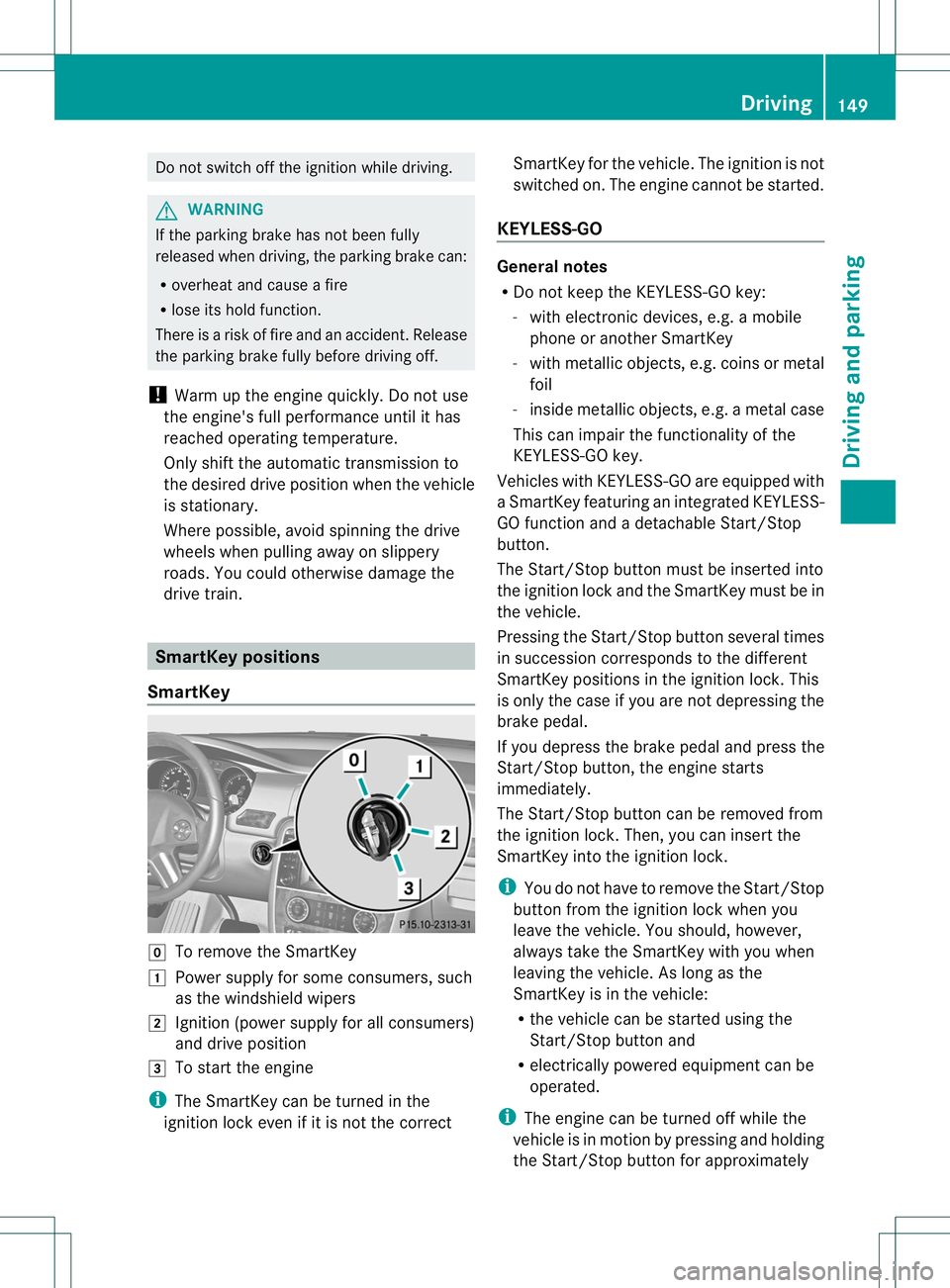
Do not switch off the ignition while driving.
G
WARNING
If the parking brake has not been fully
released when driving, the parking brake can:
R overheat and cause a fire
R lose its hold function.
There is a ris koffire and an accident .Release
the parking brake fully before driving off.
! Warm up the engine quickly. Do not use
the engine's full performance until it has
reached operating temperature.
Only shift the automatic transmission to
the desired drive position when the vehicle
is stationary.
Where possible, avoid spinning the drive
wheels when pulling away on slippery
roads. You could otherwise damage the
drive train. SmartKey positions
SmartKey g
To remove the SmartKey
1 Power supply for some consumers, such
as the windshield wipers
2 Ignition (power supply for all consumers)
and drive position
3 To start the engine
i The SmartKey can be turned in the
ignition lock even if it is not the correct SmartKey for the vehicle. The ignition is not
switched on. The engine cannot be started.
KEYLESS-GO General notes
R
Do not keep the KEYLESS-GO key:
-with electronic devices, e.g. a mobile
phone or another SmartKey
- with metallic objects, e.g. coins or metal
foil
- inside metallic objects, e.g. a metal case
This can impair the functionality of the
KEYLESS-GO key.
Vehicles with KEYLESS-GO are equipped with
aS martKey featuring an integrated KEYLESS-
GO function and a detachable Start/Stop
button.
The Start/Stop button must be inserted into
the ignitio nlock and the SmartKey must be in
the vehicle.
Pressing the Start/Stop button several times
in succession corresponds to the different
SmartKey positions in the ignition lock. This
is only the case if you are not depressing the
brake pedal.
If you depress the brake pedal and press the
Start/Stop button, the engine starts
immediately.
The Start/Stop button can be removed from
the ignition lock. Then, you can insert the
SmartKey into the ignition lock.
i You do not have to remove the Start/Stop
button from the ignition lock when you
leave the vehicle. You should, however,
always take the SmartKey with you when
leaving the vehicle. As long as the
SmartKey is in the vehicle:
R the vehicle can be started using the
Start/Stop button and
R electrically powered equipment can be
operated.
i The engine can be turned off while the
vehicle is in motion by pressing and holding
the Start/Stop button for approximately Driving
149Driving and parking Z
Page 171 of 364
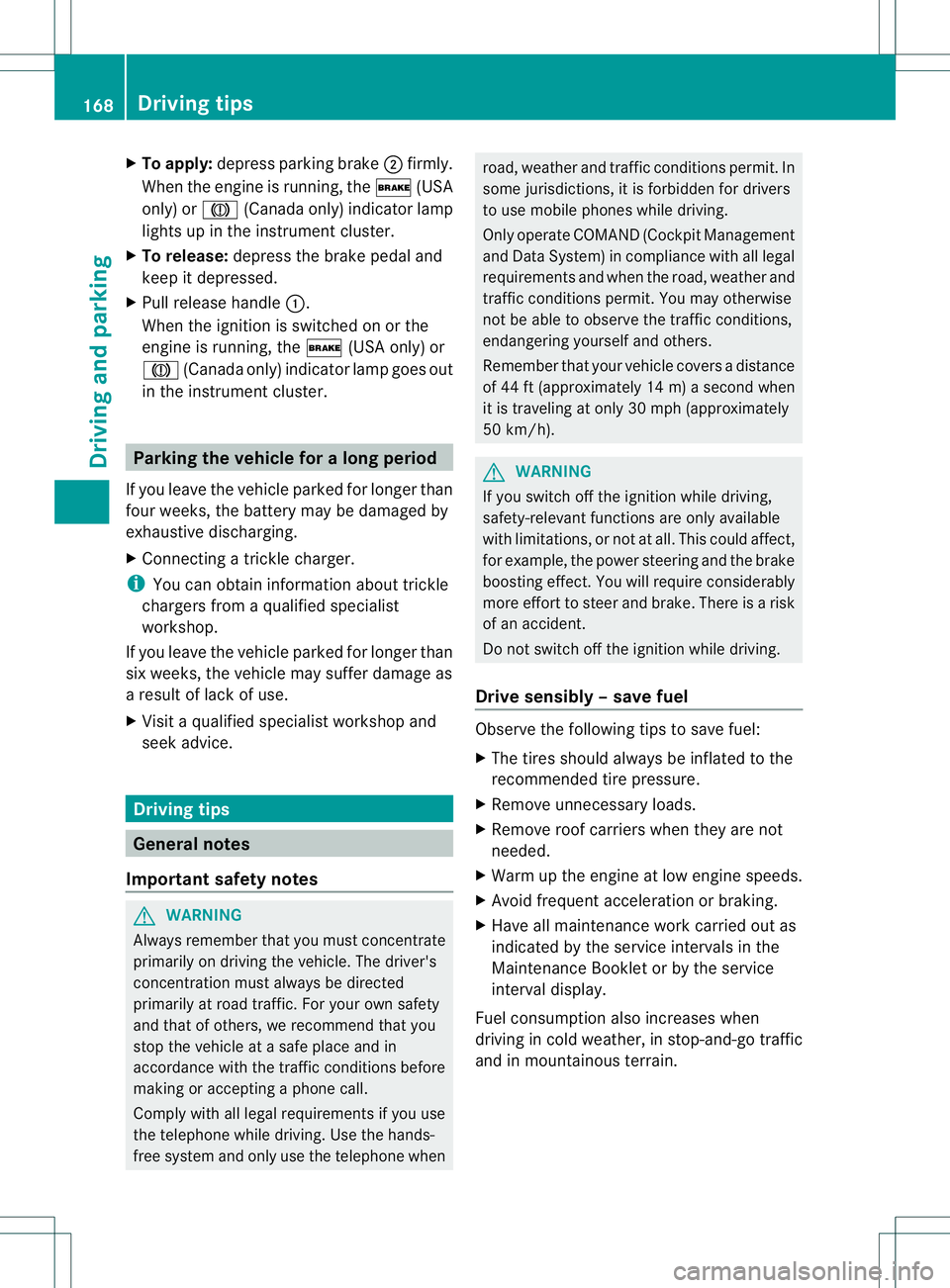
X
To apply: depress parking brake ;firmly.
Whe nthe engine is running, the $(USA
only) or J(Canada only) indicator lamp
lights up in the instrumentc luster.
X To release: depress the brake pedal and
keep it depressed.
X Pull release handle :.
When the ignition is switched on or the
engine is running, the $(USA only) or
J (Canada only) indicator lamp goes out
in the instrument cluster. Parking the vehicle for
along period
If you leave the vehicle parked for longer than
four weeks, the battery may be damaged by
exhaustive discharging.
X Connecting a trickle charger.
i You can obtain information about trickle
chargers from a qualified specialist
workshop.
If you leave the vehicle parked for longer than
six weeks, the vehicle may suffer damage as
a result of lack of use.
X Visit a qualified specialist workshop and
seek advice. Driving tips
General notes
Important safety notes G
WARNING
Always remembe rthat you must concentrate
primarily on driving the vehicle. The driver's
concentration must always be directed
primarily at road traffic. For your own safety
and that of others, we recommend that you
stop the vehicle at a safe place and in
accordance with the traffic conditions before
making or accepting a phone call.
Comply with all legal requirements if you use
the telephone while driving. Use the hands-
free system and only use the telephone when road, weather and traffic conditions permit. In
some jurisdictions, it is forbidden for drivers
to use mobile phones while driving.
Only operate COMAND (Cockpit Management
and Data System) in compliance with all legal
requirements and when the road, weather and
traffic conditions permit. You may otherwise
not be able to observe the traffic conditions,
endangering yourself and others.
Remember that your vehicle covers a distance
of 44 ft (approximately 14
m)a second when
it is traveling at only 30 mph (approximately
50 km/h). G
WARNING
If you switch off the ignition while driving,
safety-relevan tfunctions are only available
with limitations, or no tatall. This could affect,
for example, the power steering and the brake
boosting effect .You will require considerably
more effort to steer and brake. There is a risk
of an accident.
Do not switch off the ignition while driving.
Drive sensibly –save fuel Observe the following tips to save fuel:
X
The tires should always be inflated to the
recommended tire pressure.
X Remove unnecessary loads.
X Remove roof carriers whe nthey are not
needed.
X Warm up the engine at low engine speeds.
X Avoid frequent acceleration or braking.
X Have all maintenance work carried out as
indicated by the service intervals in the
Maintenance Booklet or by the service
interval display.
Fuel consumption also increases when
driving in cold weather, in stop-and-go traffic
and in mountainous terrain. 168
Driving tipsDriving and parking
Page 204 of 364

i
The light sensor in the instrument cluster
automatically controls the brightness of
the multifunction display.
Displays and switches in the vehicle
interior: if the light switch is set to Ã,
brightness control takes ambient light into
account. If the light switch is set to Tor
L, brightness control does not take
ambient light into account. Tachometer
! Do not drive in the overrevving range, as
this could damage the engine.
The red band in the tachometer indicates the
engine's overrevving range.
The fuel supply is interrupted to protec tthe
engine when the red band is reached. Outside temperature display
G
WARNING
The outside temperature indicator is not
designed to serve as an ice-warning device
and is therefore unsuitable for that purpose.
Indicated temperatures just above the
freezing point do not guarantee that the road
surface is free of ice. The road may still be icy,
especially in wooded areas or on bridges.
The outside temperature display is in the
multifunction display (Y page 203).
Changes in the outside temperature are
displayed after a short delay. Speedometer with segments
The segments in the speedometer indicate
which speed range is available.
R DISTRONIC activated (Y page 175):
One or two segments in the set speed
range light up.
R DISTRONIC detects a vehicle in front: The segments between the speed of the
vehicle in front and the stored speed light
up. Operating the on-board computer
Overview :
Multifunction display
; Right control panel
= Left control panel
X To activate the on-board computer: turn
the SmartKey to position 1in the ignition
lock.
You can control the multifunction display and
the settings in the on-board computer using
the buttons on the multifunction steering
wheel.
Left control panel ~ R
Rejects or ends a call
R Exits phone book/redial
memory 6 R
Makes or accepts a call
R Switches to the redial memory Displays and operation
201On-board computer and displays Z